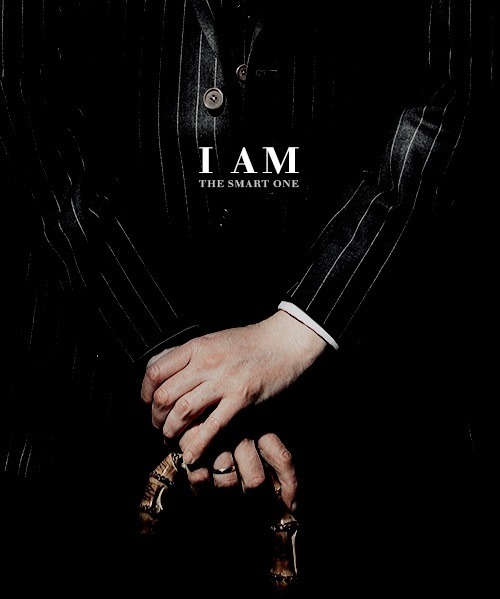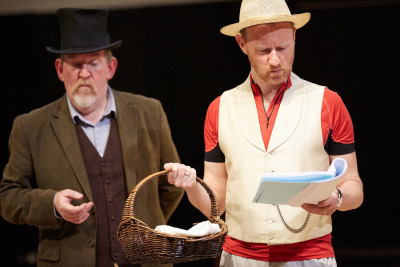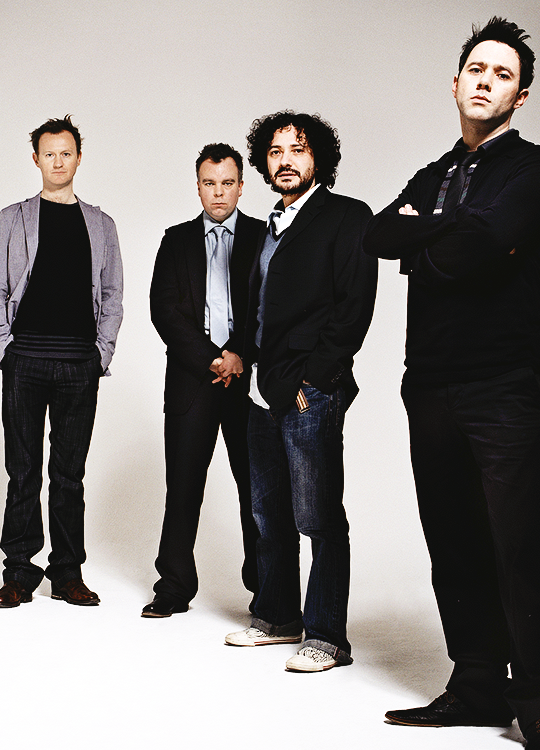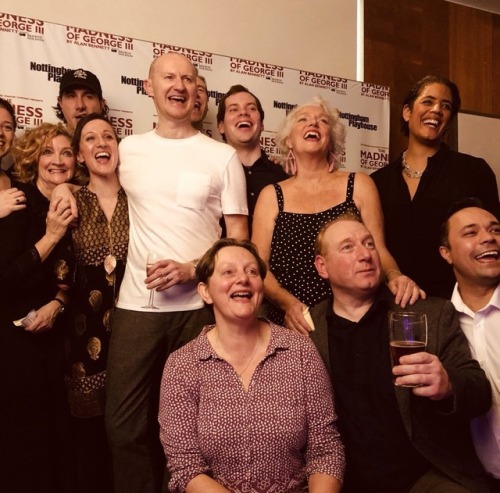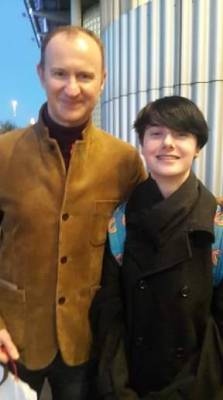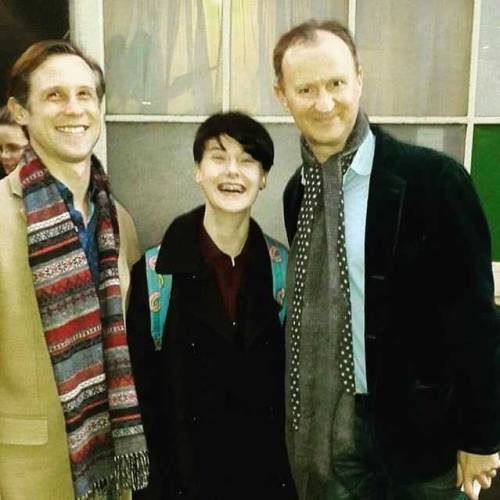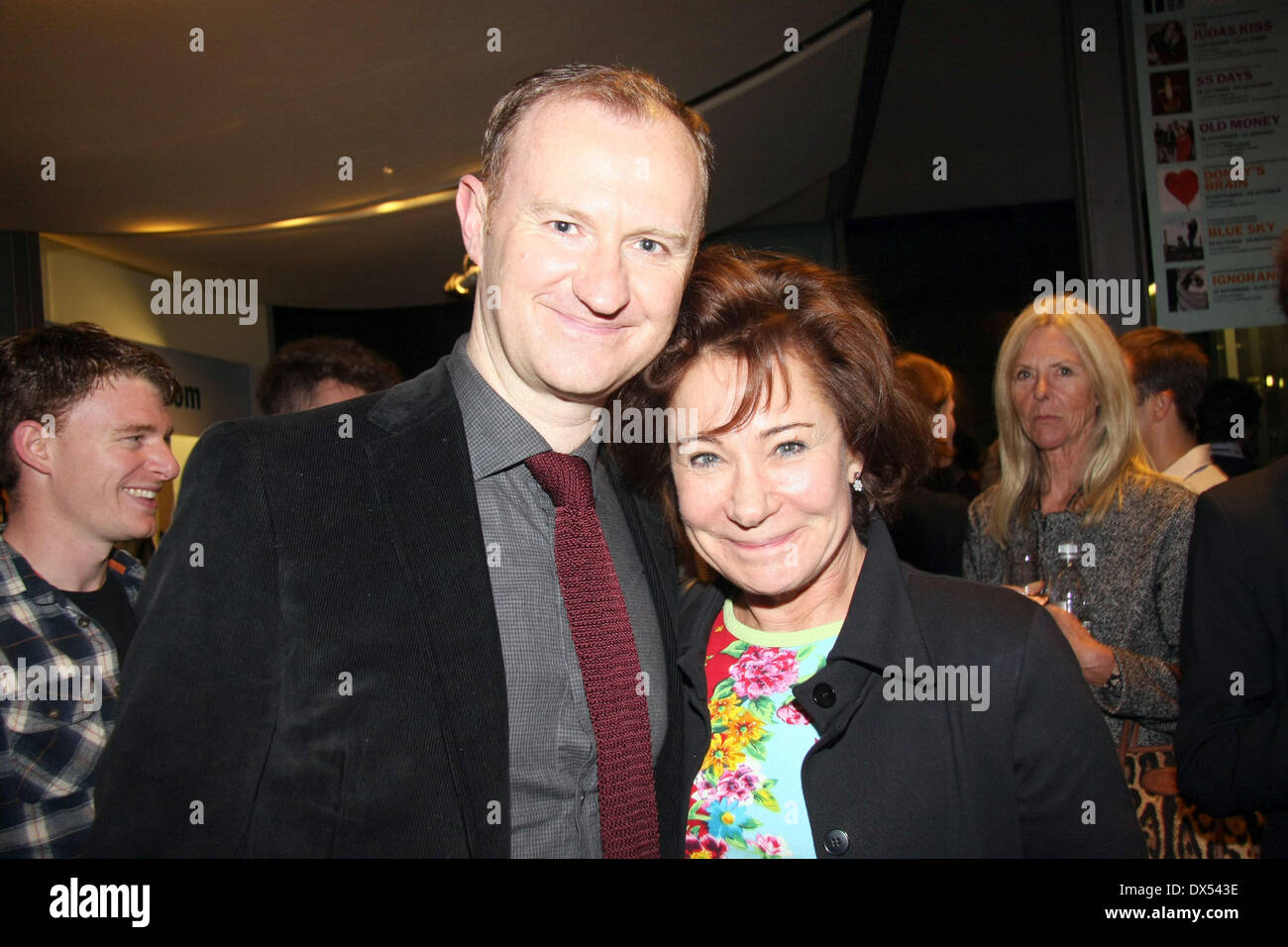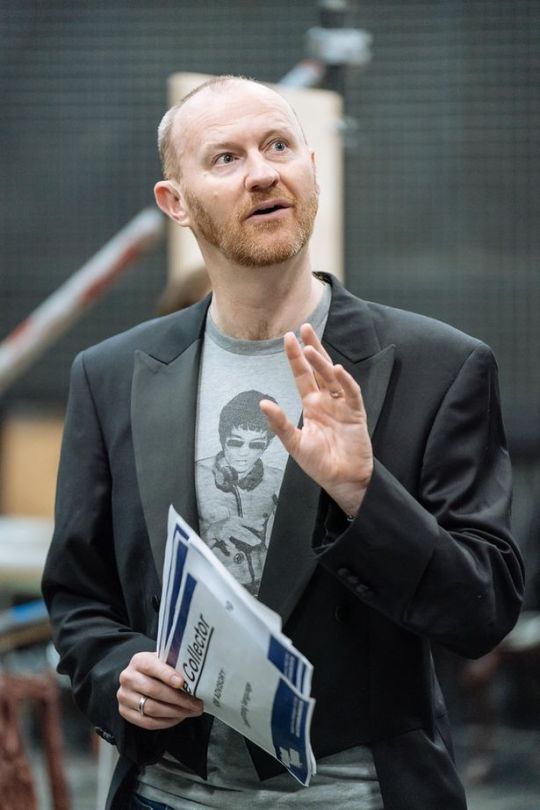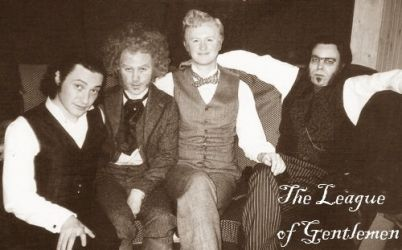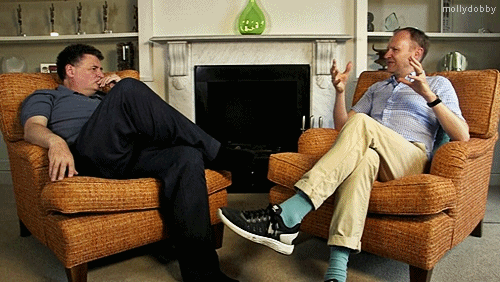A place to keep my thoughts ordered. Help me write. Learn the language. Express myself without making blunders and create misunderstandings.
Sunday, 23 December 2018
Saturday, 15 December 2018
Review: The Madness of George III, National Theatre Live
Review: The Madness of George III, National Theatre Live: Mark Gatiss deserves all the praise for his role as King George III.


The Madness of George III by English playwright Alan Bennett (The History Boys, The Lady in the Van), premiered in 1991 and was then made into a BAFTA Award-winning film starring Nigel Hawthorne.
The story of the Regency crisis of 1788-89, The Madness of George III is here revived by the Nottingham Theatre and brought to us by National Theatre Live. Directed by Adam Penford, the production is a triumph, particularly for Mark Gatiss in the lead; he brings to the stage astonishing range and power.
It’s 1788 and King George III suffers from porphyria, an inherited genetic condition which affects the skin and the nervous system, and which brings about disordered thinking and behaviours. It appears the king might be going mad. Bennett has him undergoing a mental breakdown, with the loss of America playing heavily on his mind. Not only is the health of the monarch precarious but that of the nation: if George III is declared unfit to rule, the dissolute and profligate Prince of Wales (Wilf Scolding) will assume the throne. The present Prime Minister, the frugal and sensible Pitt (Nicholas Bishop), will be the first to go. Disaster looms.
The Crown Prince is conspiring with the medical team of court doctors to bring about the King’s downfall by employing increasingly barbaric treatments and separating him from his loving Queen, Charlotte (Debra Gillett).
One of the symptoms of porphyria is acute sensitivity and blistering of the skin, and the torments of George when he endures the tortures of being cupped are hard to take. You curl up in your seat. Adrian Scarborough plays the tough-loving but honest Dr Wills who – unimpressed by the king’s status and believing that George is suffering from having been over-indulged – is determined to bring about a cure by breaking the man like a horse. The scenes with these two are magnificent; two powerful actors at their best.
The production is cast genderblind as there are only two female roles, the Queen and Lady Elizabeth (Sara Powell). Amanda Hadingue is a stand-out, playing the Prince’s man, Fox, and one of the court doctors.
The play widens and contracts from scene to scene, zooming in to excruciatingly intimate scenes of the king’s mental anguish, or of loving companionship with his wife, then rapidly zooming out again in to portray the life of court and politics. The set by Robert Jones is all angles and decorated panes, referencing the rigid formality of courtly life. Against this, Gatiss delivers a heroic performance; the King’s disintegration is accompanied by a playful and knowing self-awareness, and the audience is privy to it all.
Practically every National Theatre Live offering is a treat. The Madness of George III is an example of the very best of British theatre. Nothing not to rave about.
Five stars: ★★★★★
National Theatre Live presents
The Madness of George III
By Alan Bennett
Directed by Adam Penford
Director for Screen: Matt Woodward
Cast includes Mark Gatiss and Adrian Scarborough
The Madness of George III
By Alan Bennett
Directed by Adam Penford
Director for Screen: Matt Woodward
Cast includes Mark Gatiss and Adrian Scarborough
Screening in selected cinemas on 15 December: see www.sharmillfilms.com.au for details.
Review: The Madness of George III, National Theatre Live
Review: The Madness of George III, National Theatre Live: Mark Gatiss deserves all the praise for his role as King George III.
Thursday, 6 December 2018
Tuesday, 27 November 2018
Thursday, 22 November 2018
Sunday, 18 November 2018
Friday, 16 November 2018
THE LEAGUE OF GENTLEMEN’S MARK GATISS TAKES A TRIP TO THE MOON

THE LEAGUE OF GENTLEMEN’S MARK GATISS TAKES A TRIP TO THE MOON
Comedian, actor and writer Mark Gatiss has been making quite a name for himself. From working on the new Doctor Who behind the screen (as a writer of 2005’s the Unquiet Dead and later the Idiot’s Lantern) and in front of the camera (in The Lazarus Experiment). He also starred opposite future Doctor Who David Tennant in the 2005 live transmission revival of the Quatermass Experiment. In 2008, he wrote and starred in the Holiday Horror special The Crooked House. From the radio to the TV screen and even the cinema, his work as a member of the League of Gentlemen has nearly made him a household name.
So what’s next?
Gatiss is currently working on a production of H.G. Welles’ The First Men in the Moon and he is beaming with pride about it. Starring as Professor Cavor, Gatiss and Rory Kinnear (of Waking the Dead) travel to the moon using an unlikely element called ‘cavorite.’ The actor is ecstatic to bring to life the turn of the century classic. “I’m completely delighted to have the chance to bring this wonderful, funny, charming and scary story to BBC4. It’s very rare to be able to adapt a genius like HG Wells for the small screen and we hope to do full justice to his extraordinary vision.”
Gatiss’ love of Victorian England is already plain to see in his Lucifer Box series, rumored to be developed into a TV miniseries by the BBC (what IS the story on that??). First Men in the Moon will be played on BBC4. No news yet on a cross the pound presentation.
Sunday, 11 November 2018
Saturday, 10 November 2018
Mark Gatiss, Ian Hallard, fan selfie - from tumblr
Thursday, 8 November 2018
Mark Gatiss - The Madness of George III - my thoughts on the actor and the man behind the character.

Mark Gatiss - The Genius in Action
I have been wanting to write about my obsession with this Master crafter for some time now. But, words never seem enough to express his ingenuity.
There seems to be a rare quality of self-effacement that allows him to blend into any role, overpowering the audience with his on-screen persona, transforming the scene into a whole new Universe.
The spectator feels the emotions rippling away from the character, touching their mind and soul, leaving a lasting impression.
Tuesday, 6 November 2018
Mark Gatiss in The Madness of George III at Nottingham Playhouse: first look photos
 |
© Manuel Harlan |
Adam Penford directs a new revival of Alan Bennett's classic
Photos have been released offering a first look at The Madness of George III, which opens this month at Nottingham Playhouse.
The new revival of Alan Bennett's piece stars Mark Gatiss as the titular tortured king, who is beset by psychological problems during his reign. The show also features Adrian Scarborough as Dr Willis Debra Gillett as Queen Charlotte.

Bennett's show won a string of awards when it first debuted in 1991 starring Nigel Hawthorne, as did the 1994 film adaptation.
Completing the cast are Nicholas Bishop (Twelfth Night) as the Prime Minister, Wilf Scolding (The Glass Menagerie) as the Prince of Wales, Harry Kershaw (Mischief Movie Night) as the Duke of York, Sara Powell (La Peste) as Lady Pembroke, Nadia Albina (Emilia) as Captain Fitzroy, Jack Holden (Ink) as Captain Greville, Amanda Hadingue (A Small Family Business) as Charles Fox and Stephanie Jacob (Absolute Hell) as Sheridan, Louise Jameson (Ten Times Table) as Dr Warren, Andrew Joshi (The Railway Children) as Lord Dundas, Billy Postlethwaite (The Plague) as Braun, Jessica Temple (The Mikado) as Papandiek, David Hounslow (This House) as Thurlow and Adam Karim (East is East) as Fortnum.
The show is designed by Robert Jones with lighting design by Richard Howell, sound design by Tom Gibbons, movement by Lizzi Gee, fight direction by Jonathan Holby, voice coaching by Hazel Holder, wig design by Richard Mawbley and wardrobe by Poppy Hall.
Running until 24 November, the production will be broadcast live from the theatre to cinemas around the world on Tuesday 20 November.
Dracula on Netflix by Mark Gatiss and Steven Moffat
 | |||
It was announced this week that Netflix and BBC One are teaming up to co-produce a miniseries titled Dracula based on author Bram Stoker‘s novel of the same name.
The miniseries comes from Sherlock creators Steven Moffat and Mark Gatiss. And like a season of Sherlock, it will consist of three 90-minute episodes.
Continue below for more info.
Here’s the full announcement from Netflix:
BBC One has commissioned Dracula from the co-creators of multi-award-winning hit BBC drama Sherlock. It will be produced by Hartswood Films and is a co-production between BBC One and Netflix.
A little over a year ago, around the time that the first part of the latest adaptation of Stephen King’s IT directed by Andy Muschietti was set to release, it was announced that Paramount was developing their own Dracula project with Muschietti attached to direct. That film is co-written by Bram Stoker’s great-grandnephew, Dacre Stoker. So fans of the character have plenty to look forward to.
BBC One and Netflix Co-Producing ‘Dracula’ Miniseries From The Creators Of ‘Sherlock’
|
Monday, 5 November 2018
Sunday, 4 November 2018
Saturday, 3 November 2018
Mark Gatiss - Man of the Year 2016

Introducing Mark Gatiss, actor, screenwriter, television producer, comedian, novelist, director and Winq’s 2016 Man of the Year, presented with his award by Winq‘s Editor-in-Chief, Matt Cain, at our 2016 awards luncheon, supported by United Airlines.
Most gay men understand gallows humour. It’s the go-to defence when life is at its bleakest. Only one, we suggest, has elevated it to an art form – our Man of the Year, Mark Gatiss. From the attack on the senses that was The League of Gentlemen and roles in Game of Thrones and Wolf Hall, to the craft of taking on the dual roles of co-writer and co-star of the spectacular Sherlock, his work uses darkness to find light. It’s positively inspirational, if occasionally uncomfortable to watch. Out and proud – or “never in”, as he has it – he would be touched by genius, were genius so minded.
Mark on his first paid writing gig: “The first money I ever earned was from writing horror stories at school, in which all the teachers we hated were violently murdered, and I would charge people to read them. A particularly-hateful PE teacher got speared on a javelin. Many years later, when I wrote my first episode of Poirot, a PE teacher – who was shot in the book – got speared on a javelin in my version!”
Mark on his attraction to the darker side of life: “Morbid curiosity! But I think it’s one of those things that changes as you get older. Without sounding like some fucking evangelical, which I’m not, I find life is so dark at the moment that I slightly shrink away from the things I used to enjoy. That’s not to say I think everything should be like a variety show, but I’m less interested in the more obviously-darker aspects of things.”

Mark on same-sex weddings (and his own!): “I was haunted by the spectre of how gay weddings were regarded growing up. It’s still a thing in the popular press – or not-so-popular press. Like when Cameron and Clegg did their press conference for the coalition they still described it as a ‘gay wedding’; there’s something slightly nasty about that. “I was really wary of pink Rolls-Royces and things like that. But it got to the stage where we were outlining our slightly-austere wedding to a friend and she said, ‘It sounds like you’re apologising for it.’ It really hit home and after that we thought, ‘Fuck it!’ We went up the aisle to the theme of Upstairs, Downstairs, our dog was our ring bearer and we exited to our favourite Eurovision winner.”
Congratulations to Mark Gatiss, our 2016 Man of the Year! Pick up your copy of Winq Winter 2016, out now, to read the full eight-page feature, along with all the other interviews with our Men of the Year.
Posted on 07/12/16 by Tim Heap
Posted in Articles, Culture | Tags Doctor Who, Game of Thrones, Gay, Mark Gatiss, Sherlock, Television, The League of Gentlemen, TV, Winq, Winq Men of the Year, Winq Men of the Year Awards, Wolf Hall
Posted in Articles, Culture | Tags Doctor Who, Game of Thrones, Gay, Mark Gatiss, Sherlock, Television, The League of Gentlemen, TV, Winq, Winq Men of the Year, Winq Men of the Year Awards, Wolf Hall
Mark Gatiss - Robert Cecil

How did you become involved with this project?
It’s a murky and interesting time politically and geo-politicallyMark Gatiss
I’d heard whispers of the project on the grapevine, and was really keen to be involved so I went in for an audition and met the director J Blakeson, who then asked me to do it. It’s a really, really good script. I was immediately struck by the way there’s a kind of contemporary parallel too. For example, there’s a scene where I have to persuade the King that the threat from the Catholics is real and that new laws need to be applied to combat it. It jumped out at me straight away that you could imagine Robert Cecil in another administration in a similar situation, trying to convince the leader that they need to suppress an insurgency.
How was working on a story that you must have been familiar with, growing up with the name Guy Fawkes?
Bonfire Night is a big thing, but it feels like all the fireworks and the bonfire itself makes it seem like the actual story is fading in people’s minds. I have talked to a lot of people who have a very muddled idea about what actually went on, so I think it’s a good time to try to tell a version of what happened.
I read The Gunpowder Plot: Terror And Faith In 1605 by Antonia Fraser years ago, and I was struck how a lot of the facts you take for granted are actually quite different - as history is often written by the winners. It never occurred to me as a kid that we were burning a Catholic in effigy, you just don’t really think about those things - it’s just a bit of fun involving sparklers and Roman candles. There’s all kinds of theories about the extent to which Robert Cecil, my character, knew about the plot and allowed it to cook in order to get the maximum dramatic impact when surprising them almost in the act of lighting the gunpowder - to give the King as big a shock as possible.
There’s even a theory that Cecil might have even come up with the plot himself. Who knows…! But what I think is interesting is that Guy Fawkes is the name, but it’s very much Catesby’s story. Rather thrillingly, Kit Harington is descended from Catesby, so it’s his baby and it’s all come together quite interestingly.
Can you introduce us to your character, Cecil?
I play Robert Cecil, who is essentially the King’s chief minister and spymaster. He did the same job for Elizabeth before her death, and his father did the same before him so his loyalty is very much to the crown and state. He’s definitely a ruthless man in ruthless times, but it’s a much more shaded argument than people might think. It’s not just bad Catholics who want to blow up the King, there are terrible things being done against the Catholics in the name of justice and reason. It’s an extremely interesting and murky time politically, and Cecil’s loyalty is absolutely to the crown and he will do anything to make things run smoothly. He’s the archetypal, shadowy, creepy man behind the throne - there because he was born into power.
In person, Cecil is described as being a very small man with a hunchback. I think Queen Elizabeth called him a monkey, and James called him his beetle - all rather unkind references. We can’t be sure what his spinal deformity was, but in order to nod to this I am playing him with his neck locked to one side - which I’m now regretting because it hurts a lot!
What was it like to be involved in the project?
I said this when I was doing Wolf Hall, but Gunpowder is the sort of thing that I grew up watching on the BBC and I was desperate to be a part of it. It was really great to be up in Yorkshire too, as I’m from Durham - which is not far from here. We filmed at all of the abbeys in the area, including some which I had never been to before - it was like an Alan Bennett gazetteer. I saw a tourist watching us filming at the beautiful Fountains Abbey one day, and thought that this is exactly what you want to happen when you visit Fountains Abbey - you hope that someone will be doing a historical recreation of something.
What’s special about Gunpowder?
Well I think it’s a great script, it’s very tight and it’s a thriller really. If you think you know what happened, it’ll teach you that there are all kinds of different aspects to the plot and the reasons why Catesby and the other conspirators wanted to blow up Parliament. There is a real sense of what the consequences would have been if the plotters had succeeded, but there is balance - you also see how the Catholics were suffering at the time. You see a country wrestling with the idea of a new and very much untried monarch who has a very particular way of ruling, mixed with the ever-present threat of invasion from Spain. It’s a murky and interesting time politically and geo-politically. I suppose really, if you think you know the story of Guy Fawkes and the Gunpowder Plot, think again…
What’s your favourite scene?
My favourite scene is a big scene with Peter Mullan, who plays Father Garnet, the chief Jesuit. In the scene, Cecil has got everything he wants and Father Garnet is tortured. I have always been a big fan of Peter’s, so it was a privilege to do it. It was wonderful to see him work and to be opposite it. I’m also looking forward to the fireworks at the end… surely that is how it must finish?!
Friday, 2 November 2018
Thursday, 1 November 2018
Wednesday, 31 October 2018
Tuesday, 30 October 2018
The Road
 |
| The Road - Adrian Scarborough and Mark Gatiss |






 |
| Nigel Kneale |
Hauntings in a local wood bring terror to a 18th century neighbourhood.
For those who don’t know the origins of this play, it was written by Quatermass creator Nigel Kneale in 1963, and broadcast on the BBC; a further version was produced for Australian television. Neither of these exist – except (as radio writer Toby Hadoke explains in his behind the scenes interview coming to SFB this week) for certain sound effects that were necessary for the play’s climax. It’s one of the legendary Lost Works – up there for fans with missing Doctor Who or Avengers episodes.
But now we can hear it, in Toby Hadoke’s chilling adaptation, suitably kept for Halloween week. If you know the story, then rest assured that every audio trick in the book has been used to ensure that the play’s ending is created in a way that emphasises the juxtapositions involved; if you don’t, then try not to be spoiled before you hear it.
Hadoke has tweaked the Kneale script in places to suit the new medium in which he’s telling the story (and adding in a few nice touches of his own that reflect choices in the original script), but he’s never altered it so that it doesn’t feel like Nigel Kneale’s work – the brilliant illustration used by Radio 4 shows Kneale’s ghost in the trees (as well as Hadoke) above the key players, and I would hope that the veteran scriptwriter would be very pleased with this new interpretation. Mark Gatiss, Adrian Scarborough and Hattie Morahan make a strong central trio for the arguments, while Colin McFarlane is excellent as the voice of reason (if not Reason). Francis Magee, Ralph Ineson and Susan Wokoma are equally strong with director Charlotte Riches ensuring that as listeners, we never feel as lost as the characters. The final five to seven minutes are a masterpiece in sound presentation – one of the best uses of the medium I’ve heard on national radio for some time.
Verdict: An excellent rendition of a deservedly hailed classic. Unmissable. 10/10
Paul Simpson
Check out our preview with Toby Hadoke here, and watch out for an extensive behind the scenes interview coming later this week.
Toby Hadoke’s adaptation of Nigel Kneale’s The Road aired on October 27 to great acclaim. Here, Hadoke talks about the necessary alterations for the story, as well as its tributes to the first production…
NB This portion of the interview contains major spoilers for The Road. If you’ve not heard it yet, do so now!
Do we know if Nigel Kneale ever considered The Road as a radio script? It’s clear that what Brian Hodgson and the Radiophonic Workshop did back in 1963 was what he was after from the start – it was never going to be a big visual thing.
One of the big comments I got back from [Radio 4 Commissioning Editor] Jeremy Howe when we first pitched it was: “How is this going to work with the climax relying on a juxtaposition of the sound that we can hear and the visuals of the characters in the time period they are in, and the incongruity of hearing those sounds laid over the image of the people in that period clothing?”
He was quite right about that. Charlotte Riches who’s produced it has been a great advocate of mine and done pretty much everything I’ve done for radio; she’s an extremely experienced producer, and is brilliant and very hot on scripts. She said that the edit on the final five minutes of the play was the biggest and hardest job she’d had, and she’d produced hundreds of hours of radio drama. She gave herself a five-day edit on this because she knew this was going to be a biggie.
When you can see the pictures, you know where you’re supposed to be looking; when you’re listening on radio you have to create the points of view and it’s difficult to go, “Are we now with the haunting, or are we still in the woods, and those in the woods can hear the haunting?” On telly, we can see the people who can hear the haunting listening, so we have an anchor. On the radio, you go, “Why are we suddenly with the haunting?” It was really confusing to work out where the listener’s point of view was.
 They say the pictures are better on radio – but when you need to create a very specific one, it has to be much harder. I think it works – there’s a lot of very clear audio cues placing us in the period before we get the stuff that’s out of place. Therefore we know the juxtaposition has to be doing something. In the radio version you’re giving us all their reactions through the haunting…
They say the pictures are better on radio – but when you need to create a very specific one, it has to be much harder. I think it works – there’s a lot of very clear audio cues placing us in the period before we get the stuff that’s out of place. Therefore we know the juxtaposition has to be doing something. In the radio version you’re giving us all their reactions through the haunting…
We had to keep cutting back to them. In the original, the haunting is just a series of fractured sounds, whereas in ours, it was Charlotte’s idea that we needed a narrative in the haunting to follow. We have a mother and a lost daughter character in the haunting who are entirely our invention, so we have a little mini story to follow within the haunting itself, otherwise we weren’t quite sure if it wasn’t going to be too fragmented and too confusing to follow.
All the dialogue in the haunting is entirely new, and we planned that quite hard… apart from the object that you can hear that is taken from the original BBC tapes. Although the play doesn’t exist, I had a bit of a brainwave. I dropped Mark Ayres an email and said, “I don’t suppose in your hall of records for the BBC Radiophonic Workshop the sound effects for The Road exist?” and he said, “I’ve got a tape here that says The Road.” He’s a superstar and sent me what was there, and we seeded a couple of bits in just because it’s a play about sound travelling through time, so why not have sound from the original play travelling through time to us? I thought that was nicely appropriate and a nice nod to the great people who went before us.
 The original version was post-Cuba with the threat of nuclear holocaust very present – did you consider changing what the tragedy was that caused the haunting or did you want to keep it as close to the original as possible?
The original version was post-Cuba with the threat of nuclear holocaust very present – did you consider changing what the tragedy was that caused the haunting or did you want to keep it as close to the original as possible?
Unfortunately Donald Trump and Kim Jong Un came along and Putin as well in a sense – so I think a nuclear holocaust is something that’s still possible, and I didn’t think there was anything else it could be. It needed to be the present day, sure, but although we’ve got them listening to the news on the car radio, I didn’t want it to be too specific. Although it’s intended very much that the day of the haunting is the day that we’re listening to it – it’s happening to us – I thought it would sound a bit hokey if I embedded it too much in the very present in terms of our immediate references.
I think it would have worked in the 1980s when the BBC very kindly did a nuclear holocaust season and they showed The War Game, and Threads was on. I remember it was the first nightmare I ever had – I slept in my sister’s room because I watched The War Game and it scared the shit out of me. It was a real threat – I lived in the countryside, and my mum still lives there; there was a radar dome on the hill and we’d always talk about that if there was a nuclear attack, they’d take out that radar dome so we’d be in the fallout anyway. We wouldn’t escape by being in the country.
It definitely was a present and terrifying threat and I just think there’s nothing else that would quite match it. The world could be wiped out by flood or famine, but I don’t think that gives you as visceral a kick.
The big difficulty we had was with one of the sounds: I thought we should have one of those nuclear sirens going off, but I made some enquires. I asked a couple of MPs and Andrew Smith (who wrote Full Circle for Doctor Who and is a former police officer), as well as Tom Harris, the former MP, about what would happen in the event of a nuclear holocaust, and the consensus was that sound is now outmoded. That alarm wouldn’t happen.
The argument, though, was people still associate it with a nuclear attack, and we should use it but in the end Charlotte made the decision not to. I would have been comfortable using it, because it’s a really useful shorthand. We didn’t, and I think that helped to divorce ourselves from the 1960s setting, but it did mean we did not have available to an aural shorthand that says immediately, “There’s a nuclear bomb!”
So you have to find a way of doing it in the dialogue without having someone say, “I always thought I’d die in a nuclear war!” Or, “Look Jane, here’s a warhead!”
 The mother and daughter bit sells that – as they’re describing the cloud. The bit that’s haunted me [and still gives me goosebumps when I transcribe this a few weeks later] is the mother saying, “Close your eyes and make a wish.”
The mother and daughter bit sells that – as they’re describing the cloud. The bit that’s haunted me [and still gives me goosebumps when I transcribe this a few weeks later] is the mother saying, “Close your eyes and make a wish.”
That’s the bit that Charlotte really loved; she said when she read it she got chills down her spine. That’s nice because I wrote that bit!
The actors in the haunting include some quite well known actors, and the girl is the daughter of the producer. Nigel Kneale’s biographer, Andy Murray, is in there somewhere – he lives round the corner from me.
How much of the 40 minutes up to the haunting did you have to rework for radio, and how much could you keep scenes intact?
Unlike [Matthew Graham’s radio play of] The Stone Tape – which I thought was very good, but was a very different retelling of the story with new characters etc. – I felt we had a slight responsibility to present the play that we cannot experience because the tape was destroyed. In the shadow of Nigel Kneale I am humbly shrouded – I had no desire to go, “And what is Hadoke’s take on Kneale’s work?” This is very much my attempt to bring the brilliance of Nigel Kneale to a current and wide audience.
There are some brilliant lines in there, but by the very nature of radio, there are changes. On telly, if you have someone talking to somebody else for two pages, you can keep cutting back to the other person for their reactions to remind you they’re in the scene. You can’t do that on radio. Some of Charlotte’s notes would be – “Jethro speaks here, he hasn’t spoken since page 32, we need to bring him in beforehand, even if it’s to drop off a drink or cough, or something.”
There were various practical things: when we get to the woods, the cart gets stuck on a knot, and that’s just to bring us into the scene. A lot of that is Charlotte’s producing experience, creating the picture for the listener.

The big thing that we brought in to it was because the scenes were quite long – which they can be on television, and certainly could be on television in 1963. For this we needed all the stuff in the woods between Big Jeff and Lukey. In the teleplay it starts off with them setting up and then they bugger off pretty quickly. In this, the stuff with Big Jeff and Lukey and Tetsy that we keep cutting back to is largely mine, setting up the ghost story and having more of the history of the haunting cut with the philosophical discourse. It was felt that we needed to have a bit more toing and froing and to get in the wood location, where the climax takes place, quite a lot earlier. Most of the stuff between those characters, and the stuff about the bones, was all new just to have a bit of a mystery around the haunting.
I had fewer characters at my disposal so I had to roll a couple into one. In the original there’s a character called Sam, played by Rodney Bewes, who is Tetsy’s sweetheart and they’re in the woods. I think it was Charlotte’s idea we roll them into one, and Sam’s the dog now! And it gives Tetsy a bigger role now.
There was a whole big team of guys helping the Squire and in my first draft I’d written lots of grunts, and cries of “You up there!” We just pared that down to Big Jeff and Lukey who do all the factotuming, because a big load of extras grunting is great on television to fill the picture but on radio it’s not particularly helpful.
In terms of the characters and the main thrusts of their arguments, the dialogue has been tweaked here and there, but large chunks are 100% Kneale. It was already great, so why mess with it?
This is the great relationship I have with Charlotte – she knows I’m an acting geek. I didn’t know you could do this until we first did a play together; she said, “Who do you think?” and I suggested a few names… and they were all in it!
We were originally going to do this in Manchester and we were going to use all local actors for the supporting parts, which I’m passionate about because I think the BBC should use more local actors when they’re recording in a place. But because we’d got Mark Gatiss it looked like we’d have to do it in London, and if we were going to be in London, and it’s only a day [recording], we decided to aim high!
We batted a few ideas back and forth. I suggested Hattie Morahan straightaway just because 1) she’s a brilliant radio actress and 2) her dad directed the original which again I thought was a beautiful tie in to the past. Charlotte knew Hattie because she’d done loads of radio. I hadn’t known their connection. Hattie was a yes pretty quickly.
Mark I mentioned was a fan in the pitch – but I didn’t ask him if he’d be in it until we got the go ahead. He was definitely the first person to be contacted, before I’d written the script but after the commission. It then depended on his availability. We were on standby for quite a while – you can’t cast until you’ve got a date – but then we got a date finally from Mark and we moved pretty quickly.
Knowing we had Mark early on we knew would bring people to it – audience-wise and cast-wise. Actors know they’re going to be in a production that people are going to want to take some notice of and if it’s got the nod from somebody who can pick and choose their work, that helps.
I wasn’t 100% certain Mark would want to do it, because he tried to remake it and wasn’t successful so I thought he might be pissed off that somebody else had. He’d also done a readthrough of it on stage a few years ago, so maybe he’d played the part and got it out of his system. He’s always been very nice to me when I met him, so the approach wasn’t totally out of the blue and I thought he wouldn’t tell me to piss off, he would let me down gently. That’s the fear when you get in touch [with actors] out of the blue: you don’t want them to be rude to you, but I knew from my limited experience that Mark wouldn’t be mean, so I went for it.
Francis Magee is a brilliant actor and an old mate of mine and I wanted to give him a job – not that he needs one! He never stops working! I love him to death and I could just imagine him as Lukey so I suggested him.
I worked with Colin McFarlane years and years ago; he’s got a brilliant voice. I suggested him.
 We had a few names in the frame for Big Jeff and then Emily, the production assistant, suggested Ralph Ineson because she always wanted to work with him. I said, “Go on offer it to him. It’s a little role at the bottom of the credits, he’s not going to go for it…” and he said yes. I wasn’t going to argue with that – he’s got the perfect voice for a tall Northern man.
We had a few names in the frame for Big Jeff and then Emily, the production assistant, suggested Ralph Ineson because she always wanted to work with him. I said, “Go on offer it to him. It’s a little role at the bottom of the credits, he’s not going to go for it…” and he said yes. I wasn’t going to argue with that – he’s got the perfect voice for a tall Northern man.
Tetsy was quite hard to cast – Susan Wokoma was the only part I didn’t cast. I’d not worked with her before but she’s very much of the moment and brought a very different energy to it. She was Charlotte’s suggestion.
Then Adrian Scarborough – we had loads of ideas for Sir Timothy and there was an actor in the frame who couldn’t do it. It’s a potentially very boring part because he’s slightly stiff and credulous. I needed somebody who was able to bring a slightly different energy to it. I thought of Adrian whose work I’d always liked – I’ve seen him on stage a lot. He’s an interesting left field idea so I suggested him and Charlotte went, “ooh let’s try him”. I thought he’d be good but he’s even better than I thought. It’s a tricky part and he’s made it really sing. I’m really happy with what he did with it.
It’s really helped me with my Quatermass book because [Nigel Kneale’s widow] Judith Kerr came to the recording. I’d been trying to get in touch with her to talk about the Quatermass book, but I’d never been able to get past the agent. She came to the recording of The Road, she was delightful, I chanced my arm and said I’m doing a book on Quatermass. I took her for dinner, and she took me round to the house. She’s got the Thing from The Quatermass Experiment out of a plastic bag in the corner of the office; she took me up to Nigel’s office where there’s a Martian sitting in the corner and gave me access to stuff I had no idea existed.
[Added October 29] Have you been pleased with the play’s reception?
I’m staggered – the response had been amazing. I mean, I knew there’d be a small coterie of people like me who would be keen on it (but then they might have hated it because it’s not 100% the original, so even they were a worry!) but the response has been huge. We trended on Twitter! And loads of people who knew nothing about the play before have got in touch to say how great it was an how floored they were by the ending. Someone even Tweeted to say it’s got his 11 year old son into radio drama which has made me overjoyed!
And then last night I got an email from Judith Kerr saying how much she enjoyed it and that “Tom would have loved it.” I’m not afraid to say that got me a bit emotional. So job done. It’s been a totally thrilling experience from start to finish and I’m very lucky to have had this opportunity.
Photos from the recording (c) Toby Hadoke and used with kind permission.
Subscribe to:
Posts (Atom)

